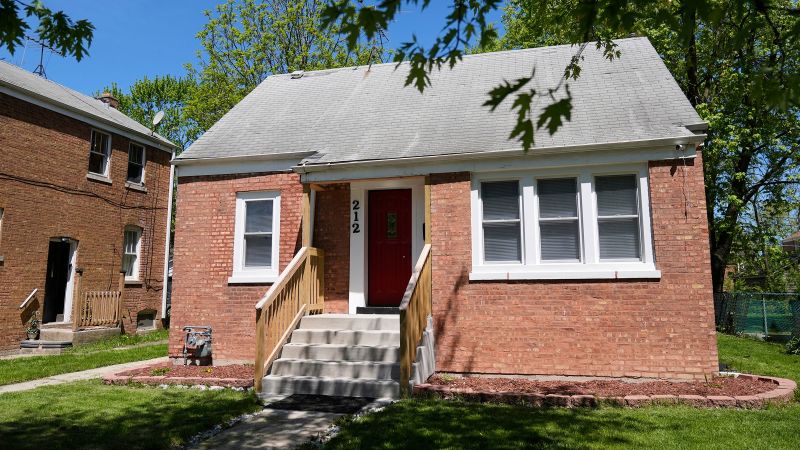A village in Chicago’s south suburbs is poised to purchase Pope Leo XIV’s childhood home after its board voted unanimously on Tuesday to take control of the property. The small, two-story house on E. 142nd Place in Dolton, Illinois—approximately 20 miles south of the Windy City—has gained national attention since the pope’s election, drawing visitors and those interested in the leader’s early life.
Leo, previously known as Cardinal Robert Prevost, was elected in May as the first American pope—a decision that stunned many in the United States and was celebrated as a historic moment. Chicago Mayor Brandon Johnson hailed Leo’s election as “one of the biggest moments in the modern history of our city.” Born in Chicago in 1955, Prevost earned his bachelor’s in mathematics from Villanova and later received a diploma in theology from the Catholic Theological Union of Chicago. He spent decades as a missionary, including 20 years in Peru, where he is a naturalized citizen and served as a bishop.
Historic Opportunity or Financial Burden?
The Dolton Village Board members described the purchase as a “once-in-a-lifetime opportunity,” emphasizing that control over the house would allow them to “do it justice.” Dolton Mayor Jason House stated at a board meeting on Tuesday, “We can either seize this moment and move it forward, or we can let that moment go to an investor.” The acquisition is expected to enable Dolton to reevaluate enterprise and historic land zones, potentially attracting “state and congressional funds” into the town.
Other trustees expressed support for the decision, citing the homes of Michael Jackson and Martin Luther King as examples of historic sites that have economically benefited their communities. However, officials acknowledged concerns from residents about increased traffic straining already-dilapidated roads.
Community Concerns and Economic Implications
Longtime Dolton resident Mary Avent voiced her concerns to CNN affiliate WBBM, stating, “Purchasing the pope’s house is admirable, but with the state we’re in right now, I guess my concern is, do we have the money?” Avent highlighted the absence of a police and fire chief in Dolton, which she believes is a more pressing issue.
Trustee Edward Steave assured residents that their complaints were valid but asserted, “we can do this great thing at the same time.” The sale is likely to close within the next two weeks, according to the mayor. Photos posted on the village’s Facebook page late Tuesday show workers conducting repairs to the roof of the pope’s house, though it remains unclear whether these repairs are directed by the town.
Comparative Analysis: Historic Homes and Economic Development
The decision to purchase the pope’s childhood home brings to mind other instances where historic homes have been leveraged for community development. The Graceland Mansion in Memphis, Tennessee, for instance, has become a significant tourist attraction, drawing thousands of visitors annually and contributing to the local economy. Similarly, the Martin Luther King Jr. National Historical Park in Atlanta serves as a cultural and educational hub, attracting scholars and tourists alike.
According to a study by the National Trust for Historic Preservation, historic sites can significantly boost local economies. The study found that for every dollar invested in historic preservation, communities see a return of $1.25 in economic activity. This potential economic benefit is likely a driving force behind Dolton’s decision to purchase the pope’s childhood home.
Looking Ahead: Potential Outcomes and Challenges
The purchase of Pope Leo XIV’s childhood home could indeed bring economic revitalization to Dolton, but the village must navigate the challenges of balancing historic preservation with community needs. The influx of visitors could strain local infrastructure, necessitating improvements to roads and public services.
Moreover, the village will need to secure funding for the house’s maintenance and potential conversion into a museum or cultural site. This will require strategic planning and possibly partnerships with state and federal agencies to ensure the project’s success.
As Dolton moves forward with this ambitious project, the community will be watching closely to see how the village balances the dual goals of honoring a historic figure and addressing pressing local issues. The outcome could serve as a model for other communities considering similar initiatives.
About The Author
 Celebrate July 4th in Anne Arundel County: Fireworks and Parades Guide
Celebrate July 4th in Anne Arundel County: Fireworks and Parades Guide Energy Policy Clash Intensifies Between Maryland’s Governor and Legislature
Energy Policy Clash Intensifies Between Maryland’s Governor and Legislature Tehama County Grand Jury Urges Red Bluff to Bolster Road Repair Efforts
Tehama County Grand Jury Urges Red Bluff to Bolster Road Repair Efforts Top 15 Girls Lacrosse Players of 2025: The Citizen All-Stars
Top 15 Girls Lacrosse Players of 2025: The Citizen All-Stars American Men’s Wimbledon Drought: A 25-Year Quest for Glory
American Men’s Wimbledon Drought: A 25-Year Quest for Glory